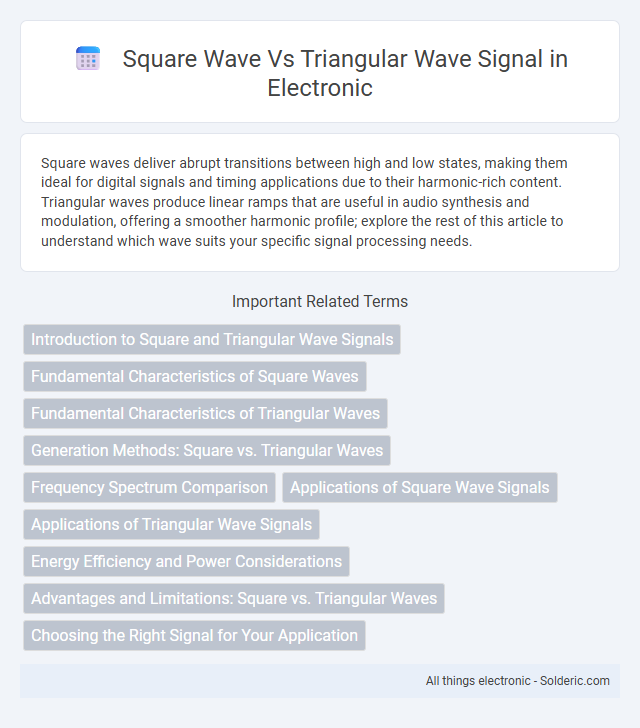Square waves deliver abrupt transitions between high and low states, making them ideal for digital signals and timing applications due to their harmonic-rich content. Triangular waves produce linear ramps that are useful in audio synthesis and modulation, offering a smoother harmonic profile; explore the rest of this article to understand which wave suits your specific signal processing needs.
Comparison Table
| Feature | Square Wave | Triangular Wave |
|---|---|---|
| Waveform Shape | Alternates between two fixed levels with instantaneous transitions | Linear ramp up and down forming a triangular shape |
| Frequency Components | Contains odd harmonics with significant high-frequency content | Contains odd harmonics with rapidly decreasing amplitude |
| Duty Cycle | Typically 50%, but can vary | 50% by definition |
| Amplitude | Fixed amplitude, switches between two levels | Linear amplitude change between positive and negative peaks |
| Uses | Digital clocks, switching power supplies, timing circuits | Signal processing, audio synthesis, modulation |
| Signal Slope | Infinite slope (vertical edges) | Constant slope (linear rise and fall) |
Introduction to Square and Triangular Wave Signals
Square and triangular wave signals are fundamental in electronic signal processing and synthesis, each characterized by distinct waveform shapes and harmonic content. A square wave alternates abruptly between high and low states, producing a waveform rich in odd harmonics ideal for digital and switching circuits. Triangular waves, with their linear rise and fall, generate a softer sound with fewer high-frequency harmonics, making them useful in audio synthesis and modulation applications.
Fundamental Characteristics of Square Waves
Square waves exhibit rapid transitions between high and low voltage levels, creating a waveform with distinct, sharp edges ideal for digital clock signals and switching circuits. Their harmonic content consists exclusively of odd harmonics, producing a rich, buzzy sound that carries significant energy at higher frequencies compared to triangular waves. Your applications will benefit from the square wave's well-defined timing intervals and ease of generation in electronic circuits.
Fundamental Characteristics of Triangular Waves
Triangular waves exhibit linear, symmetrical rise and fall times, creating a continuous, non-abrupt waveform with a fundamental frequency containing only odd harmonics that diminish in amplitude by the square of their harmonic number. This distinct harmonic structure results in a softer sound and reduced high-frequency content compared to square waves, which have sharp transitions and include odd harmonics with amplitude inversely proportional to the harmonic number. Understanding the fundamental characteristics of triangular waves can enhance your signal processing applications by providing smoother waveform generation with minimal high-frequency noise.
Generation Methods: Square vs. Triangular Waves
Square waves are typically generated using digital circuits like flip-flops or Schmitt triggers that switch output between high and low states abruptly, producing sharp transitions. Triangular waves are produced through the integration of square waves or by using linear sweep circuits such as function generators with op-amps configured in an integrator topology. Your choice between these signals depends on the desired waveform shape, frequency accuracy, and application in signal processing or testing environments.
Frequency Spectrum Comparison
Square wave signals contain a fundamental frequency accompanied by strong odd harmonics with amplitudes decreasing proportionally to the inverse of harmonic order, resulting in a rich and complex frequency spectrum. Triangular wave signals also consist of odd harmonics but with amplitudes decreasing much faster, proportional to the inverse square of the harmonic number, producing a smoother waveform with fewer high-frequency components. This difference in harmonic content makes square waves ideal for applications requiring sharp transitions, while triangular waves are preferred where lower spectral noise and smoother signals are essential.
Applications of Square Wave Signals
Square wave signals are widely used in digital electronics for clock pulses, timing circuits, and switching power supplies due to their rapid transitions between high and low states. They serve as essential signals in pulse width modulation (PWM) for motor control and power regulation. In communication systems, square waves facilitate binary data encoding and signal processing applications.
Applications of Triangular Wave Signals
Triangular wave signals are widely utilized in signal processing and electronic testing due to their linear rise and fall characteristics, ideal for system response analysis. They serve as essential inputs in function generators for modulating circuits and in audio synthesizers to create distinct sound timbres. Triangular waves also play a crucial role in pulse-width modulation (PWM) techniques for efficient power control in motor drives and switching power supplies.
Energy Efficiency and Power Considerations
Square wave signals typically consume more power due to their abrupt transitions and rich harmonic content, leading to higher energy losses in most power electronic applications. Triangular wave signals, with their smoother linear transitions and lower harmonic distortion, offer improved energy efficiency and reduced electromagnetic interference. When optimizing Your system for power efficiency, triangular waves are often preferred in applications requiring minimal energy dissipation and heat generation.
Advantages and Limitations: Square vs. Triangular Waves
Square waves offer rapid switching with sharp transitions, making them ideal for digital circuits and timing applications, but generate more harmonic distortion and electromagnetic interference. Triangular waves produce smoother, linear ramps that reduce harmonic content, benefiting audio synthesis and modulation, though their slower rise time limits high-speed switching performance. Your choice depends on balancing signal purity with switching speed requirements.
Choosing the Right Signal for Your Application
Square wave signals offer sharp transitions with a high harmonic content, making them ideal for digital circuits and clock timing applications where precise switching is essential. Triangular wave signals provide a linear ramp up and down, beneficial for audio synthesis, modulation, and testing linear response in systems. Understanding your application's needs for signal shape, harmonic spectrum, and frequency response helps ensure you choose the right waveform for optimal performance.
square wave vs triangular wave signal Infographic

 solderic.com
solderic.com